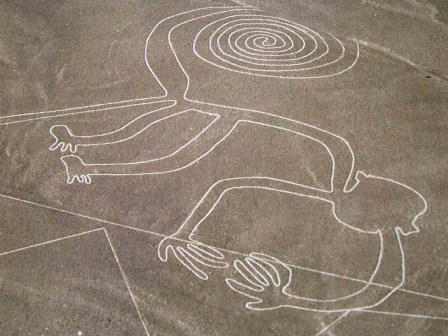Nazca civilization destroys deforestation
Nazca, an illustrious ancient civilization in South America, has collapsed due to deforestation, causing the climate to become dry and hot, recently published by British scientists.
Nazca is a people who lived in the southern coast of Peru from about 200 BC to 600 AD. They are famous for creating giant drawings in the desert that people can observe today from airplanes. Since its discovery in 1939, these drawings have attracted millions of tourists each year.

Huge Nazca figures in the desert of southern Peru.
However, the Nazca civilization suddenly abated and disappeared about 1,500 years ago. Previously, archaeologists believed that the El Nino weather phenomenon - which caused heavy rain and flooding - pushed the Nazca to extinction. But this hypothesis is not widely accepted.
Over the years, scientists from Cambridge University (UK) have studied the cause of the Nazca tribe's civilization collapsed. They concluded that the Nazca people could not grow food in the valleys near the desert because they did not have enough trees. The lack of vegetation makes the climate too dry and the food crop is not growing.
In the November issue of the American Antiquity Latin article, the team said that a few dozen centuries ago, the valleys inhabited by the Nazca were full of huarango trees. This plant can live for over 1,000 years and has a great role in stabilizing soil moisture and fertility. But for hundreds of years, they are constantly being cut to make room for crops.
At a certain point, the number of huarango trees is cut so much that the balance of the ecosystem is broken by the climate in too dry valleys. 'Nazca's mistake gives us many important lessons about protecting the current ecosystem' - Oliver Whaley, a scientist at the Royal Kew Botanical Garden (UK), one of the participants Research and comment.
- May Maya civilization collapse due to deforestation?
- Is there a solution to the mysterious Nazca line?
- The implications of the prehistoric giant figures
- Figure 30 m long monster sticking tongue on the Peruvian plateau
- Norway is officially the first country in the world to commit to deforestation
- Decode mystical drawings in Peru
- New weapon to prevent deforestation
- Behind the fall of the Maya empire
- Mysterious trophy trophy in South America
- Discovered more than 20 strange giant drawings in the desert of Peru
- Deforestation makes seeds difficult to regenerate
- Redefining the age of Indian civilization
 Discovered an ancient centipede fossil 99 million years old
Discovered an ancient centipede fossil 99 million years old Discovered bat-like dinosaurs in China
Discovered bat-like dinosaurs in China Discovered a 200-year-old bronze cannon of the coast
Discovered a 200-year-old bronze cannon of the coast Discover 305 million-year-old spider fossils
Discover 305 million-year-old spider fossils